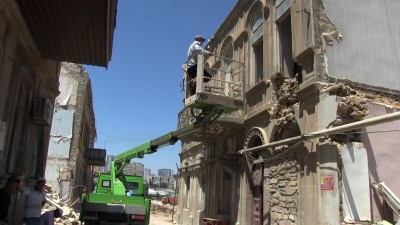
Emin Isayev, lawyer
Demolishing of private living residences and buildings in the territory called Sovetski, “Outside City” as historically, the major issues have been discussed regarding Baku city for the last two years. Demolishing here was started following the December 12, of 2013 dated decree “On implementation of moving in a range of residential and non-residential areas defined in Yasamal district in connection with provisions of General Plan of Baku City”. Although the decree specifies that demolishing in “Sovetski” area shall be held only by voluntary agreement of property owners, executive power organizations used different methodology such as pressure or cutting communication tools for moving the residents out. According to the information dated January of 2016, measurements were carried in 8759 addresses located in residential and non-residential areas during 2015. It is noted that 2698 residents were already paid compensations. 2320 residential and non-residential spaces are planned to be demolished, in general, 1795 out of which is already demolished. 45 of 2320 residential and non-residential spaces are historical buildings.
But the absence of an agreement with residents of private flats, as well as the existence of numerous historical buildings in the area where demolitions are planned has not prevented to continue demolishing works. So non-agreement by the side of residents voluntarily and their resistance based on the rights provided by the constitution was complicated even more by decree number 358 on compulsory purchase of these apartments by the state issued by the Cabinet of Ministers on November 11, 2015.
As follows from the decree of the Cabinet of Ministers 1093 residential and nonresidential objects planned to be demolished in “Sovetski” area. A decision on compulsory purchase was explained with the need of building state importance roads and other communication lines referring to non-existing General Plan of Baku City.
Talking of historical buildings located in a demolishing area, the fact that they exist here have not become a reason to change plans on demolishing or to stop it. The issue was also “solved” by the May 18, 2016, dated decree of the Cabinet of Ministers. By removing 23 locally important historical buildings from the list of “historical and cultural monuments” based on opinion of the National Academy of Sciences that the buildings do not carry any historical value and opinion of the Ministry of Culture and Tourism on absence of cultural importance, Cabinet of Ministers deprived these buildings from state protection in the background of demolishing process.
Historical and cultural monuments protected by the state, following August 2, 2001, the decision of the Cabinet of Ministers “On approval of the division of historical and cultural monuments under state protection in the territory of the Republic of Azerbaijan depending on their importance”, were classified as world, country and local importance. That list defines 6308 cultural monuments up-to-date.
During last 15 years, Cabinet of Ministers made more than 20 changes to this list by the authority to make amendments and changes to the list of historical and cultural monuments. However, Cabinet of Ministers is authorized to remove from the list only monuments confirmed by parliament according to the October 16, 2012, amendment made to the law “On protection of historical and cultural monuments.”
After the changes made to the law on different dates Cabinet of Ministers made a decision on removal of historical monuments with local and country importance from that list. The biggest number is with the decision number 269 by Cabinet of Ministers dated to July 23, 2015. By that decision 169 historical monuments of local importance and three historical monuments of the country were removed from the list of historical monuments.
Nevertheless the law “On protection of historical and cultural monuments” defines that classification of historical monuments based on their importance level and their removal shall be implemented by the requirements of international conventions ratified by Azerbaijanian state.
Azerbaijan ratified Convention of UN on Economic, Social, and Cultural Rights on August 13, 1992. Also, it undertakes international obligations prohibiting forced removal and demolishing under the jurisprudence of the European Court as a participant of convention “On Human Rights and Fundamental Freedoms” since April 15 of 2002. At the same time on November 26, 2009, the Republic of Azerbaijan joined the convention “On Protection of European Architectural Heritage” signed on October 3, 1985, in Granada.
In its October 22, 2015 “Khaligov vs. Azerbaijan” decision European Court acknowledged the fact of violation of property and apartment rights protected by European Convention on Human Rights in the demolishing process carried out by the state on the territory adjacent to “Sovetski” area.